Ireland 1916 - Sligo Poets
Main menu:
- Home
-
1912
- 1912
- Sligo Poetry 1912
-
1913
- 1913
- Sligo Poetry 1913
-
1914
- 1914
- Sligo Poetry 1914
-
1915
- 1915
-
Sligo Poetry 1915
- Sligo Newspaper Poems
- Sligo Champion
- Sligo Independent
- Sligo Nationalist
-
1916
- 1916
-
Sligo Poetry 1916
- Sligo Newspaper Poems 1916
- Sligo Champion
- Sligo Nationalist
- Sligo Independent
- The Poets
- Bibliography
- The Author
Ireland 1916
January: James Connolly, the labour leader, joins the Irish Republican Brotherhood (IRB) and is voted onto the Military Council. Easter Sunday is confirmed as the date for the rising.
20–21 April: The German cargo steamer SS Libau, renamed SS Aud, is intercepted by the Royal Navy and scuttled following an unsuccessful attempt to land arms for the Volunteers in Tralee Bay.
21 April (Good Friday): Roger Casement and two others are arrested at Banna Strand, County Kerry, for attempting to land arms and ammunition.
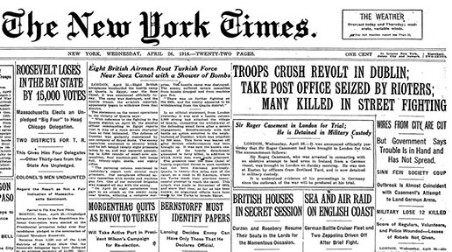
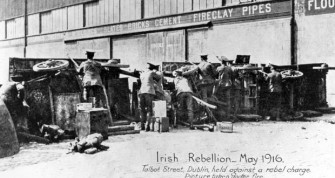
English troops under fire in Talbot Street. Photograph: Ann Ronan Pictures/Print Collector/Getty Images.
From this website.
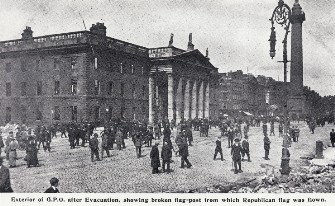
Exterior of GPO after evacuation, showing broken flag-
From this website.
22 April: Eoin MacNeill, Chief of Staff of the Irish Volunteers, cancels all manoeuvres of Volunteers planned for the following day.
23 April (Easter Sunday): The IRB military council decides to begin the insurrection at noon the following day.
24 April: The Easter Rising begins. The Irish Volunteers and the Irish Citizen Army occupy the General Post Office and other buildings in Dublin city. Patrick Pearse reads the proclamation outside the GPO.
27 April: Major-
27 April:The only large scale engagement outside the city of Dublin occurs at Ashbourne, County Meath where the Fingal Battalion led by Thomas Ashe and Richard Mulcahy took the RIC barracks and ambushed an RIC patrol from Slane. Eight RIC constables, two Volunteers and one civilian killed.
29 April: Pearse surrenders unconditionally.
3:12 May: Following courts martial, fifteen men executed for their involvement in the rising, including all seven signatories of the proclamation.
11 May: During a debate in Westminster on the situation in Ireland, John Dillon of the Irish Parliamentary Party calls on the government to end the executions of the leaders.
12 May: The final executions, of Seán Mac Diarmada and James Connolly, take place. Prime Minister Asquith begins a week-
15 May: In London, Roger Casement is charged with high treason for his part in the rising.
1 July: The Battle of the Somme begins. The 36th Ulster Division, which contains many Ulster Volunteers, loses over 5,000 men in the first two days.
3 August: Roger Casement is hanged at Pentonville Prison for high treason.
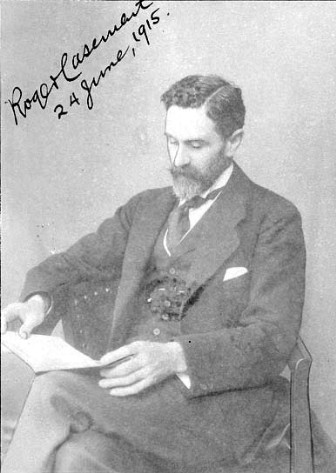
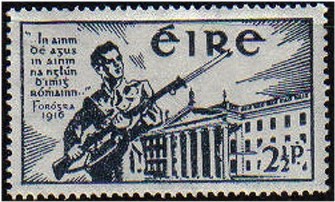
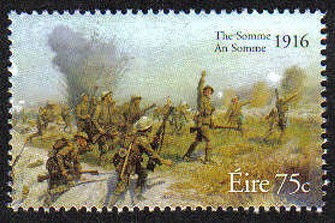
7 August: A large audience attends the first screening of the Film Company of Ireland’s first film O'Neill of the Glen, directed by J. M. Kerrigan, at the Bohemian Theatre in Dublin.
29 October: John Redmond demands the abolition of martial law, the release of suspected persons, and that Irish prisoners be treated as political prisoners.
18 November: The Battle of the Somme ends.
21 December: In the House of Commons, it is announced that all Irish prisoners are to be released.
25 December: The last group of released Irish prisoners arrive in Dublin.
29 December: James Joyce's novel A Portrait of the Artist as a Young Man is first published in book form in New York.
Irish stamps. Top: Issued in 1941 to commemorate the 1916 Rising.
Bottom: Issued in 2006 to commemorate the Battle of the Somme.